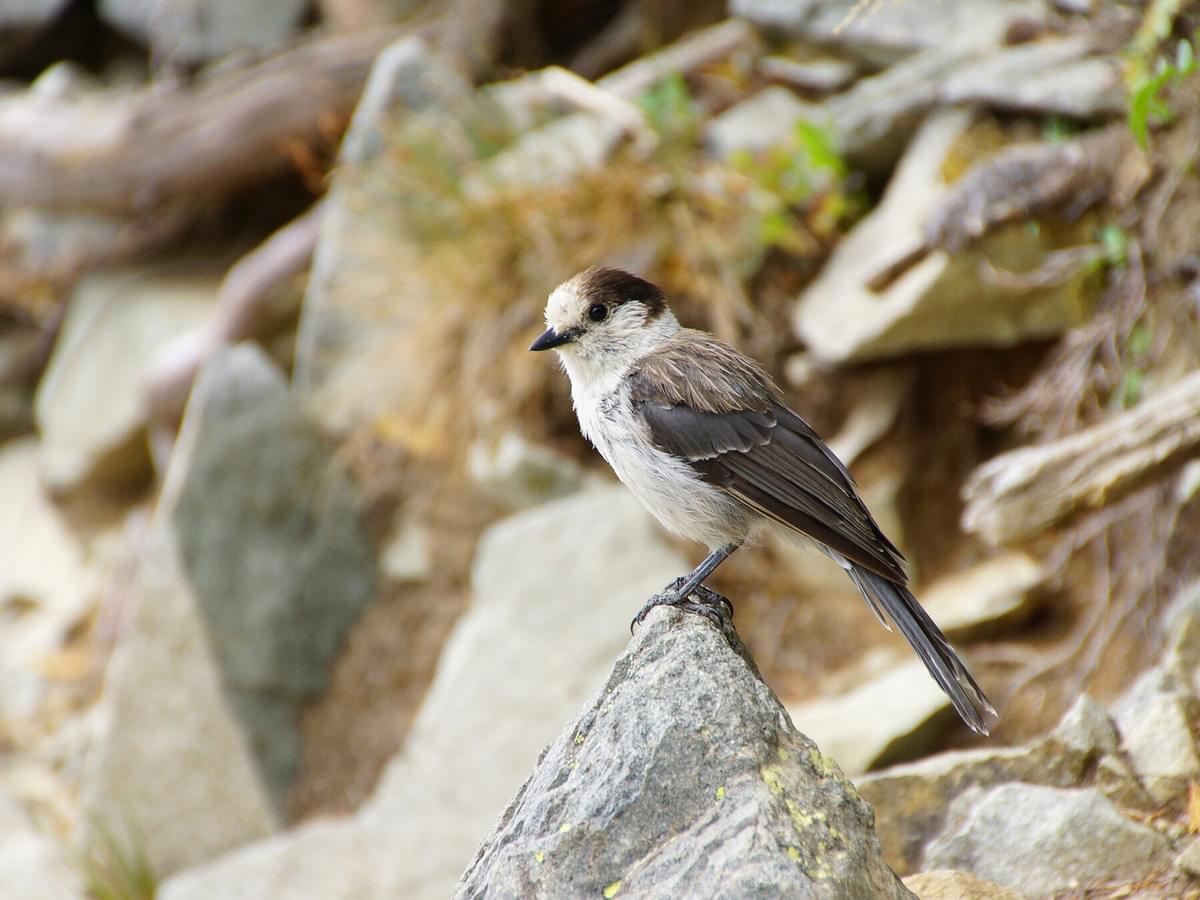Jump to Section
What Is The National Bird of Canada? (And Why)
Last updated: 1 August 2022

The national bird of Canada, officially chosen just four and a half years ago, is the ever charming gray jay (Perisoreus canadensis), sometimes referred to as whiskey jack.
The gray jay may seem like an odd choice to anyone unfamiliar with the bird. However, once you learn the qualities and significance of this bird, you will see why it is a perfect choice.
The gray jay - native to the entire country - has long been revered by Indigenous Peoples; its significance is held especially by the Cree. In fact, the name whiskey jack was derived from the Cree’s traditional name for this bird, Wisakedjak. Gray jays are also an important indicator species - their presence aids in studying the health of Canada’s boreal and mountain forests.
These are only a few reasons behind the decision to dub the gray jay Canada’s national bird. In this article, we will take a deeper dive into why this jay is a perfect choice and what it represents. We’ll also discuss the gray jay as a species. Read on to discover more!

Canadas National Bird, the Gray Jay
Why is the gray jay the national bird of Canada?
The gray jay was chosen as the national bird of Canada because, after much consideration, no other bird fit the bill better. The gray jay is tough, curious, friendly, and historically significant. They were known by Indigenous Peoples as teachers and messengers of the forest. Gray jays assisted hunters by giving warning calls when other predators were nearby and helped those who were lost find their way back home.
Even today, gray jays are commonly known to follow hikers, skiers, and anyone else wandering Canadian mountains and forests. They make wonderful companions when one chooses to join you on an outing.
Their curiosity often leads them to follow folks for quite some time. They will also hang around your campsite. Their friendly nature is seen as representative of Canada as a whole.
This small but legendary bird is also native to all 13 provinces and territories. The gray jay is present throughout Canada year-round. It remains in northern mountains and boreal forests long after other birds have migrated south to warmer regions.
Despite its relatively small size, this jay is known to withstand temperatures as low as -30 degrees Fahrenheit. Whiskey jacks fare extremely well in harsh Canadian winters.
Further proving this point by their habit of nesting and incubating eggs as early as February, when snow still lays thick in the coniferous forests.

Canada Gray Jay in the snow
When did the gray jay become the national bird of Canada?
The voting and decision-making process for choosing Canada’s national bird began in 2015. However, the decision was not made official until 2017. Over 100 birds were in the running, but, after some careful consideration, five were chosen for the vote.
The common loon actually won the popular vote, but the Royal Canadian Geographic society chose the gray jay instead. The Society believed the jay to be more representative of Canada as a whole.
Who chose the gray jay to be the national bird of Canada?
The Royal Canadian Geographic Society chose the gray jay as the national bird of Canada. It took nearly two years to finalize, as much debate occurred around the decision. Ultimately, the Society felt the gray jay was a more appropriate representation than the popular choice, the common loon.

Gray Jay in flight
What does the gray jay represent?
In Indigenous traditions, seeing the gray jay in the morning is a good omen. The bird was traditionally viewed as a wise teacher and even a guide. Overall, the gray jay represents a friendly and resilient spirit. These corvids are historically known as companions to those wandering the northern forests of Canada.
Learn more about the national bird of Canada
Identification
Gray jays are a member of the corvid family (i.e. crows, ravens, blue jays, Steller's jays). They are slightly smaller than the blue jay and do not have a crest. Their bodies are a medium to dark gray, while their heads are white except for a dark gray patch on the crown.
Males and females are sexually dimorphic, meaning there is no color variation in their plumage.
Habitat
The gray jay is native to the boreal and mountain forests of North America. Its primary territory lies within Canada. However, this jay is also found throughout the subalpine ranges of the mountain west in the United States.
Gray jays are non-migratory, thus, they are permanent residents within their territories. Habitats consist of coniferous or mixed-con and deciduous forests. Several qualities make these birds unique, but their ability to survive harsh northern mountain winters is most astonishing.

Gray Jay, or Whiskey Jack in its natural habitat
Nesting
Gray jays generally nest in coniferous trees such as Douglas fir, lodgepole pine, and Western hemlock. Nests are constructed out of twigs, bark strips, and lichen. The interior is lined with feathers or fur left behind by mammals.
The first eggs are laid as early as February, often requiring the female to incubate during heavy snowfall. There are some rather shocking photos of females on the nest, nearly invisible due to snow cover. Females do get up from the nest frequently (every 10-15 minutes) to shake off snow accumulation.

Canada Gray Jay on the ground
FAQs
Is it Canada Jay or Gray jay?
The gray jay was originally known by ornithologists as the Canada jay. However, in 1957, the American Ornithologists union changed the bird’s common name to gray jay.
What is the national animal of Canada?
The beaver was chosen as the national animal of Canada in 1975.

The national animal of Canada, the Beaver

